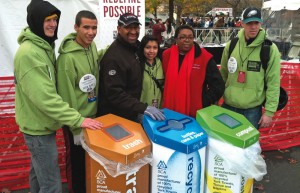BioCycle January 2013, Vol. 54, No. 1, p. 6
Residential Organics Collection Pilot
Beginning this month, approximately 7,900 curbside residential customers in the city of Austin start receiving weekly curbside collection of organic materials, which will be composted by Organics “By Gosh,” an Austin-based company. The pilot program is part of the City of Austin’s commitment to a Zero Waste goal to divert 90 percent of materials from landfills by 2040, explains Bob Gedert, Austin Resource Recovery Director. “At present, nearly half of the materials that end up in the landfill could be composted.” Austin Resource Recovery currently provides all customers with weekly curbside collection of yard trimmings set out in lawn and leaf bags or bundled in twine. Households participating in the Curbside Organics Collection Pilot received a green, 96-gallon cart for yard trimmings, food scraps and food-soiled paper. Participants also received a small food scrap collector for the kitchen.
During the one-year pilot, the city will evaluate the effectiveness of organics collection and refine its services. It will also evaluate possible costs to determine if there would be any impact on future rates, especially if households can reduce the size of their trash cart. (Austin has a variable rate trash fee based on cart size.) Households selected for the pilot include five geographic areas and represent Austin’s diverse demographics. Depending on how the pilot areas perform, additional households could be added, with the goal of providing curbside organics collection to every Austin Resource Recovery curbside customer (numbering over 182,000) by 2016.
Montreal Organic Waste Management Plan Update
Montréal, Québec, Canada’s second-largest urban area, has launched an organics waste management plan expected to lead to construction of at least two composting facilities and two anaerobic digesters within its borders. The area’s complex government structure is reflected in the plan, which will include green bin curbside collection of household organic wastes from 3.4 million people. The overall area, the Montréal Metropolitan Community, is comprised of 82 municipalities divided into five urban regions. In 2006, the Community government adopted a master waste management strategy with the regions to develop specifics.
Three years later, one of the regions — the Island of Montréal — took the lead by approving measures, including the composting plants and digesters, to handle 242,000 tons of wastes annually from 1.8 million people in the central Ville de Montréal and 13 surrounding municipalities. Final approval for facility sites is expected this month. Next, decisions on financing, public or private management and technology must be made before the project goes out to bid. While the final price hasn’t been determined, the Canadian and Québec governments have promised $135 million, with a completion deadline of 2015, says Alan DeSousa, mayor of one of the Island municipalities, Saint-Laurent, who until recently was responsible for sustainable development in the region. While the project is proceeding as quickly as possible, the deadline might have to be extended, he notes.
The province of Québec has set a target of 60 percent organics diversion by 2015 and will ban organics from landfill as of 2020. While the Island region recycles 60 percent of its household plastics, metals, paper and glass, and is aiming for 80 percent, less than 10 percent of household organics are diverted, DeSousa says. Yard trimmings, Christmas trees and the small quantity of kitchen wastes collected in pilot projects are trucked to farms off the island, where they’re composted, he explains. The aim of the plan is to process the larger quantities close to their source.
The digesters are to be built in the south and east quarters of the island, which are densely populated and generate the most kitchen wastes. Still to be decided is whether the methane produced by the digesters will be burned to generate electricity or purified into biomethane, the natural gas substitute. The composting plants will be enclosed in buildings. Their feedstock will also include digestate from the digesters. In general, the region will seek “mature” technologies, but the bid documents will be written to “attract the broadest spectrum of technology possible” that meets the specifications and offers the best price, DeSousa notes. The plan is to process only residential organics; industrial, commercial and institutional generators must come devise their own plans, he says.
Municipal Collection And Composting Program For Public Events
The city of Philadelphia, Pennsylvania recently launched a new waste collection and composting program for public events, intended to divert an estimated 2.5 million pounds of materials a year from landfills. The city is partnering with SCA, a multinational hygiene and forest products company that has its Americas headquarters in Philadelphia. Officials estimate the new program will reduce the amount of materials going to disposal by 75 percent per outdoor event. SCA invested about $175,000 to purchase, design and develop the new waste bin stations and donated them to the city for use at outdoor events. The 35-gallon capacity bins were purchased from RecyclingBin.com. The 500 stations at each large event should each collect about 113 pounds of materials, officials estimate.SCA collaborated with the Mayor’s Office of Sustainability and the Department of Streets to ensure the bin stations are easy for people to sort waste by trash, compost and recycling. The new stations were pilot tested at the Philadelphia Marathon in November. “The pilot gave us a better understanding of the infrastructure required to deploy the bins and the volume of attendees and waste the bins can successfully handle,” says Sarah Wu, policy and outreach manager for the Office of Sustainability. The city hauled the collected organics to Peninsula Compost’s Wilmington Organic Recycling Center in Delaware.
SCA is working with Philadelphia to measure the waste diverted via the stations after large events on a quarterly and semiannual basis. A similar recycling and composting program was started several years ago by the Philadelphia Eagles National Football League team that has diverted more than 3 million pounds of compostables and recyclables from landfills. City officials are hoping for similar results with the new effort.
Food Waste Prevention Toolkit
Data from the U.S. Department of Agriculture’s Economic Research Service calculated that each year, Americans throw away about one-fourth of all food purchases, at a retail value of $124 billion annually. Although the amount of food waste from households nearly equals the combined food waste from restaurants and grocers, little has been done in the way of outreach and education to address the problem. That is changing, due in part to an initiative launched in 2010 by the West Coast Climate and Materials Management Forum, which collaborated with a diverse planning team of over 25 U.S. EPA, state, city and county government partners to design a pilot program, Food: Too Good to Waste. The pilot initiative includes a research report and comprehensive toolkit to help households adopt waste prevention behaviors. This fall, San Benito (CA), King County (WA) and Boulder County (CO) began implementing the Food: Too Good to Waste pilot.
The pilot toolkit can be customized and used by any interested local government or community group. It includes a Message Map with messaging for five key waste prevention behaviors; an Implementation Guide; Behavior Change Tools, including a food storage guide, shopping template, poster and workshop presentation; and Measurement Tools, such as a food waste measurement bag design, photo diary template, impact analysis method, data worksheets and a centralized data collection system. Communities, schools, local organizations and others interested in implementing the program can send an information request to WestCoastForum@epa.gov. EPA does not have funding available for implementation but can offer helpful consultation for implementation plans and measurement goals.
Findings from the pilots launched last fall will be presented at BioCycle’s 27th Annual West Coast Conference, April 8-11, 2013 in San Diego. The BioCycle event features a preconference workshop on April 8 on Food Recovery and Recycling, and a dedicated track of concurrent sessions on a wide range of topics related to food recovery on April 9-10 during the main conference. Visit www.biocyclewestcoast.com.
England Recycles, Composts More Than It Disposes
The Department for Environment, Food and Rural Affairs (Defra) released final statistics on municipal waste collected and managed by local authorities in England from April 2011 to March 2012. According to the analysis, released in November 2012, 43 percent of household waste was recycled, composted or reused in 2011/12, representing 11.8 million tons of the waste collected. Conversely, 10.6 million tons, or 37.4 percent, of waste was landfilled. Defra noted in its report that an increase in incineration may have partly accounted for the change in landfill. In addition, while 43 percent is the highest recycling rate recorded for England, the rate of increase has been levelling off, with 2011/12 being the lowest year on year increase for ten years. Overall, household waste generation was 25.2 million tons, continuing the year on year fall seen since 2007/8. This amounts to 950 lbs of waste/person/year. Data on waste management is collected to monitor progress against the revised Waste Framework Directive target of 50 percent household waste recycling by 2020. England’s Landfill Tax continues to be the main driver for authorities to reduce waste to landfill, adds Defra.
New Recycling, Energy Recovery Complex Announced In Ohio

Solid Waste Authority of Central Ohio (SWACO) to build Center for Resource Recovery and Recycling complex.
Gemini is building a conveyor system and pedestrian walkway that crosses a highway separating the receiving facility and MRF from the industrial park, named “Synergy City.” Recyclables will be conveyed to processing facilities located in the industrial park. Synergy City is expected to be built in phases and include greenhouses, a fish farm, an anaerobic digester and other production and industrial facilities. Under the design concept, waste from one center will help fuel another.











